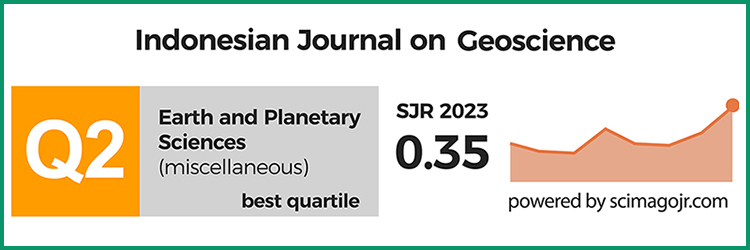Karakterisasi sumber gempa Yogyakarta 2006 berdasarkan data GPS
DOI:
https://doi.org/10.17014/ijog.3.1.49-56Keywords:
GPS data, simple kriging, sequential gaussian simulation, displacement, strain, earth-quake source, moment seismic, moment magnitudeAbstract
https://dx.doi.org/10.17014/ijog.vol3no1.20085
The southern part of Central Jawa is one of earthquake hazard prone areas in Indonesia an earthquake occurred on May 27, 2006 and had the moment magnitude 6.3.
Base on the GPS observation, the characterization of the epicenter and source of this Yogyakarta earthquake can be estimated using the displacement estimation and strain at the measurement point by using a simple kriging and sequential gaussian simulation method.
The direction of the displacement and maximum shear strain anomaly in this research was shown by the fault of SW – NE direction and the displacement pattern shows that this fault is left lateral strike slip movement. The positive anomaly of the maximum shear strainis located about 10 km east of Bantul, which suggests as the position of Yogyakarta 2006 earthquake source, with the moment seismic and moment magnitude values are 8.1385 x 1025 dyne cm, and 6.5 respectively.
References
Abidin, H.Z., 2006. Co-Seismic Deformation of the 2006 Yogyakarta Earthquake as Detected by GPS Surveys. Power Point, Merapi Workshop Yogyakarta.
Aki, K., 1968. Seismic displacements near a fault. J.Geophys, Res. 73., h. 5359 – 5375
Asdani, 2006. Gempa bumi Yogyakarta 27 Mei 2006. Powerpoint, Pusat Survei Geologi.
Bath, M., 1979. Intruduction to Seisology. Birkhauser Verlag Basel, h.61-78.
Bohling, G., 2005. Introduction to Geostatistics and Variogram Analysis. Kansas Geological Survey, https://people.ku.edu/~gbohling/cpe940/Variograms.pdf.
Kanamori, H., 1977. The energy release in great earthquakes. J. Geophys, Res. 82., h. 2981 – 2987.
Kostrov B.V., 1974. Seismic moment and energy of earthquakes and seismic flow of rock. Izv. Acad. Sci USSR, Phys. Solid Earth, 1, h. 23-40.
Oware, E.N., 1988. A New Tectonic View of The Japanese Islands based on GPS Dense Array data. A Thesis, Departement of Earth and Planetary Physics.University of Tokyo, Japan, h. 20-38.
Russell. H., 1997. Geostatistical Analysis of Well log and Seismic Data. Hamson Russel Sofware Service, Central Hongkong, h. 4-49.
Seth, S., Michael, W., 2003. An Introduction to Seismology, Earthquakes, and earth Structure. Blackwell Publishing, h. 39-49, h. 263-266.
Thorne, L., Terry, C., dan Wallace, 1995. Modern Global Seismology. Academic Pres, 34-46, 383-395.
Triyoso, W., 1991. Konsep-Konsep Dasar Seismologi. Institut Teknologi Bandung, h. 2-13, h. 48-55.
Tyson, S., 2006. Advanced Geostatistics in Reservoir Modeling. Australian School of Petroleum, Adelaide, h. 1-3.
Pramumijoyo, S., Sudarno,I., and Wartono, 2006. Yogyakarta Earthquake 2006. Geological Engineering Department Faculty of Engineering University of Gadjah Mada.
Wartono, R., (1995). Peta Geologi Lembar Yogyakarta. Pusat Penelitian dan Pengembangan Geologi.
Gempa bumi Merusak. https://merapi.vsi.esdm.go.id/
Gempa bumi Merusak di Yogyakarta 27 Mei 2006. https://www.bmg.go.id/
Magnitude 6.3-Java. https://earthquake.usgs.gov/



















